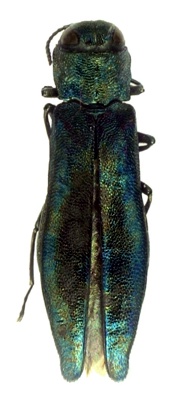Pests
Agrilus viridis (L.) - Beech Splendor Beetles (Beech Agrilus)
Systematic position.
Class Insecta, order Coleoptera, family Buprestidae, genus Agrilus Curtis.Biological group.
Pest of currant and gooseberry.Morphology and biology.
Body length, 5-9 mm. Integument of adult is coppery green, with metallic shine. Frons with arcuate punctuated striae and with white short hairlike scales. Pronotal sides angularly rounded. Elytra narrow, straightly narrowed toward apex, elytral apexes somewhat attenuated and denticulate. Larva apodal, white, dorso-ventrally flattened; thorax broader than head. Body with 2 hooklike appendages at apex. Mature larva to 17 mm in length.Distribution.
Europe northward to Scandinavia, Northern Africa, Mongolia. Inhabits most part of territory of the former USSR northward to Karelia and Komi Republic, including the Caucasus, Siberia, the Far East, Middle Asia, and Kazakhstan.Ecology.
Generation development lasts 1-2 years. Larva hibernates inside lower part of injured shoots. Diapause terminates in the end of March or in April, at average air temperature about 8°C. Pupation occurs inside shoots in the 2nd half of April or in May; pupa whitish, develops 17-21 days. After emergence, adult gnaws a hole in the shoot and appears in orchard in May-June, 7-10 days after currant blossoming. Adults become active in daytime during warm hours. They devour leaf edges in Ribes nigrum and R. rubrum. In one or two days after mating, female lays eggs by 1-2 on leafstalks and young shoots, covering them with mucous excretions which harden quickly, forming a yellowish scale. Fertility is about 22-72 eggs. Oviposition lasts about 2 months; at that time, female copulates several more times. Beetles die after the end of oviposition. Egg develops 11-17 days in the South of Ukraine. Larva hatches under scale, penetrates inside core shoot and gnaws galleries. A. viridis has several food forms which develop on deciduous plants (currant, gooseberry, birch, willow, asp, poplar, beech). Tetrastichus chearingi Hal., Kaltenbachia apum Thoms. are larval parasites, which sometimes infect about 80% of populations.Economic significance.
The beetle damages in larval stage mainly. Currant yield decreases on damaged stems two times. Pest abundance is greater in neglected and old orchards. Control measures include pruning of currant stems in spring, 4-5 days after blossoming. About 70% of larvae are destroyed after pruning. Pesticides are used to control A. viridis on the currant plantation twice, in the beginning of adult appearance and once more in 3-5 days. Ribes aureum is resistant to the pest damage.Reference citations:
Alekseev A.V. 1989. Family Buprestidae . buprestids. In: Ler P.A., ed. Keys to insects of the Far East of the USSR. V. 3. Coleoptera, or beetles. Part 1. Leningrad: Nauka, 572 p. (in Russian).Anisimova O.A. 1978. Beech splendor beetle . pest of black-currant in Amur Region. In: Kulik S.A., ed. Fauna and ecology of insects in East Siberia and Far East. Irkutsk: Irkutsk University, p. 118-124 (in Russian).
Kostin A.V. 1969. On food forms of Agrilus viridis (Coleoptera, Buprestidae). Zool. zhurnal 48 (1): 85-92 (in Russian).
Mikhal'tsov V.P. 1969. Beech splendor beetle and currant borer in Primorskii Territory. Zashchita rastenii 10: 20-21 (in Russian).
Rikhter A.A. 1944. Review of the buprestid beetles of the European part of the USSR (Coleoptera, Buprestidae). Zoological proceedings (3). Erevan: AS Arm. SSR, p. 131-176 (in Russian).
Savkovskii P.P. & Rybalov L.N. 1981. Biological properties of Agrilus viridis L. Vestnik Zoologii 1: 82-86 (in Russian).
Silfverberg H. 1992. Enumeratio Coleopterorum Fennoscandiae, Daniae et Baltiae. Helsinki-Helsingfors: Helsingin Hyonteisvaihtoyhdistys, 94 p.


